M31 - Andromeda Galaxy
For all images of M31 click here.
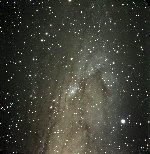 |
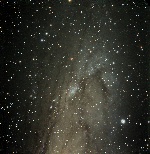 |
| Imax=1 | Nonlinear |
SBIG ST-4K, 3900s total exposure 10/3/13 Lake San Antonio, CA
This is a new attempt to capture the star clouds along the southern end of M31, including NGC 206 (the brightest patch). Numerous blue supergiant stars (and a few pink nebulae) can be seen, but the focus could have been better.
M1 - Crab Nebula
For all images of M1 click here.
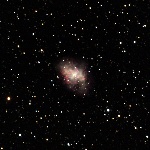 |
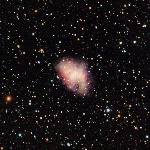 |
| Imax=3.50 | Nonlinear |
SBIG ST-4K, 1800s total exposure 10/3/13 Lake San Antonio, CA
This was an attempt to get a much deeper exposure of this famous supernova remnant in Taurus. While we succeeded in improving the signal-to-noise ratio, the focus is not quite as sharp as is in our original attempt. The 'nonlinear' version allows the outermost structure to be seen. Visually, the surface brightness is low, and I could see only a diffuse glow and not the filaments.
M42 - Orion Nebula
For all images of M42 click here.
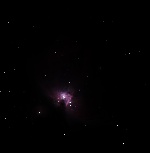 |
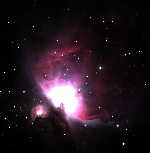 |
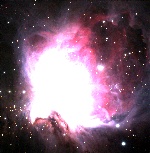 |
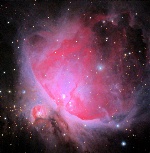 |
| Imax=350 | Imax=15 | Imax=2 | Nonlinear |
SBIG ST-4K, 1080s total exposure 10/3/13 Lake San Antonio, CA
This is another attempt at the Orion Nebula, using the new camera. Compared with the previous image, the focus is not as good, but a much larger area of the nebula is visible due to the larger sensor area and deeper exposure.
NGC 2024 - Flame Nebula
For all images of NGC 2024 click here.
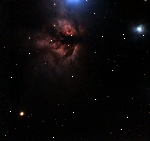 |
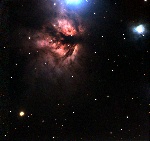 |
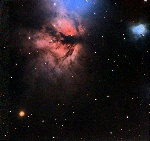 |
| Imax=3.50 | Imax=1.50 | Nonlinear |
SBIG ST-4K, 1800s total exposure 10/3/13 Lake San Antonio, CA
This is an emission / dark nebula near the belt star ζ Orionis (just outside the field of view near the top), which is thought to be the excitation source. The dark features look similar to those of the Trifid nebula, but with more detail. The reflection nebula in the upper right is NGC 2023.
NGC 2392 - Eskimo Nebula
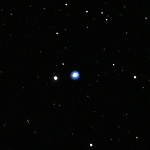 |
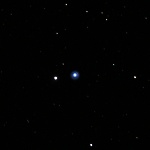 |
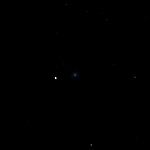 |
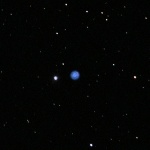 |
| Imax=25 | Imax=65 | Imax=500 | Nonlinear |
SBIG ST-4K, 300s total exposure 10/3/13 Lake San Antonio, CA
In certain photographs, this planetary nebula in Gemini resembles a face surrounded by a thick hood. For the best chance of seeing that here, tilt your head 90 degrees to the right and look at the nonlinearly scaled image. The blue and purple color combination seems unusual.
B142/143 - "E" Nebula
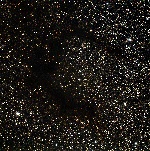 |
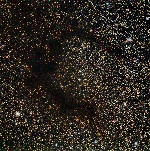 |
| Imax=1 | Nonlinear |
SBIG ST-4K, 2100s total exposure 10/4/13 Lake San Antonio, CA
This image shows the darkest portion of a dark nebula in Aquila known as the "E" nebula (the name is a little puzzling since, even in wide field images, the dark shape doesn't look much like an E). A reddening of stars near the edges of the dark patches is clearly seen. It is easier to see this in the "nonlinear" image, since the processing method used there retains the star colors even when the intensity saturates the display.
NGC 7814
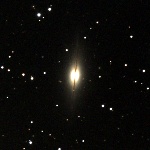 |
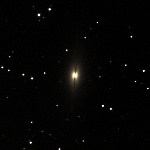 |
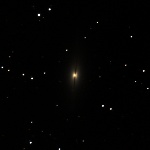 |
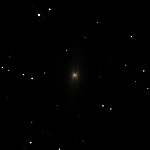 |
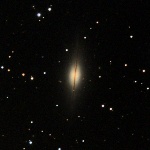 |
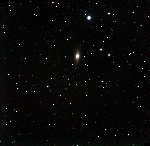 |
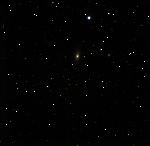 |
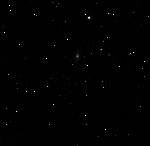 |
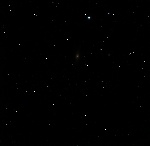 |
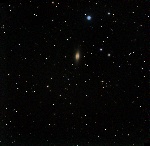 |
| Imax=1 | Imax=3 | Imax=6 | Imax=10 | Nonlinear |
SBIG ST-4K, 3600s total exposure 10/4/13 Lake San Antonio, CA
This is a spectacular edge-on spiral galaxy in Pegasus. Numerous smaller, fainter galaxies can be seen as well (this is the reason for including the uncropped versions). A faint, slow-moving object appears as a broken streak near a bright star in the lower-right part of the full-sized image. Based on its slow motion, it might be an asteroid (see Ceres below).
Perseus Galaxy Cluster
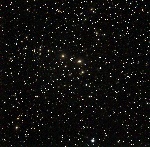 |
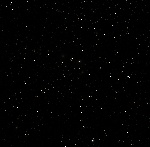 |
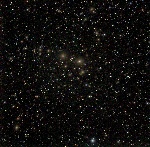 |
| Imax=1 | Imax=10 | Nonlinear |
SBIG ST-4K, 1800s total exposure 10/4/13 Lake San Antonio, CA
At an estimated distance of 240 million light years, this large galaxy cluster includes NGC 1275, which is the brightest galaxy in the image, slightly above-right from center. NGC 1275 is a strong source of radio and X-ray emission, and is thought to consist of two colliding galaxies. The resolution in this image is not good enough to see the dark lanes of the foreground galaxy clearly, though some hint of this structure can possibly be made out in the 'nonlinear' image by comparing with higher-resolution images.
NGC 2264 and Cone Nebula
For all images of NGC 2264 click here.
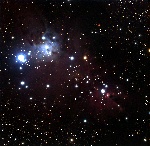 |
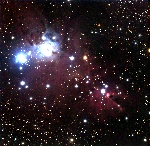 |
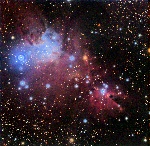 |
| Imax=1 | Imax=0.50 | Nonlinear |
SBIG ST-4K, 5400s total exposure 10/4/13 Lake San Antonio, CA
NGC 2264, in the constellation Monoceros, includes an open star cluser known as the Christmas Tree cluster (left and center), a bright reflection nebula (upper-left), a large area of faint emission, and the spectacular Cone Nebula at lower-right. The reflection nebula can be seen visually, but the emission nebula and Cone features are too faint. The distance is approximately 2700 light years.
NGC 6822 - Barnard's Galaxy
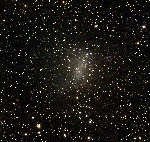 |
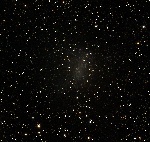 |
| Imax=0.70 | Imax=1.70 |
SBIG ST-4K, 3600s total exposure 10/5/13 Lake San Antonio, CA
At a distance of 1.6 million light years, NCG 6822 is one of the closest galaxies visible from our latitude. This small, irregular galaxy contains numerous emission nebulae, the brightest of which can be seen here. Numerous stars can be resolved, as well. The bubble-like feature at upper-right from center seems particular striking and appears similar to a feature in M33 (near the bottom of the M33 image, right of center).
NGC 278
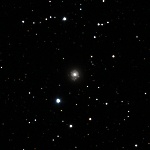 |
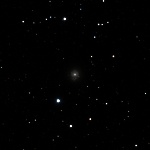 |
| Imax=7.50 | Imax=18.50 |
SBIG ST-4K, 900s total exposure 10/5/13 Lake San Antonio, CA
This is a small face-on spiral galaxy in Cassiopeia. This tiny, pearl-like galaxy is one of Kathy's picks.
IC 10
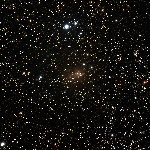 |
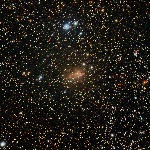 |
| Imax=1 | Nonlinear |
SBIG ST-4K, 2669s total exposure 10/5/13 Lake San Antonio, CA
IC 10 is a small, irregular galaxy in the constellation Cassiopeia. It is a member of our local group, and its distance, 2.8 million light years, is similar to that of the Andromeda and Triangulum galaxies. This image shows dust lanes and pink clouds that are apparently large emission nebulae.
AE Aurigae / IC 405
For all images of IC 405 click here.
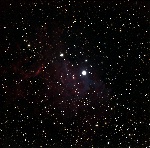 |
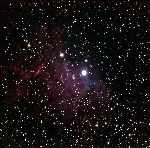 |
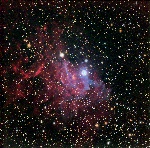 |
| Imax=2 | Imax=1 | Nonlinear |
SBIG ST-4K, 3600s total exposure 10/5/13 Lake San Antonio, CA
IC 405, also known as the Flaming Star nebula, contains clouds of dust (blue) and gas (red) that are believed to have been present before the brightest star in the image, AE Aurigae, traveled near it, providing illumination. This is our first decent image of this rather faint object after a couple of tries.